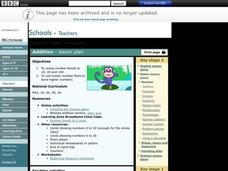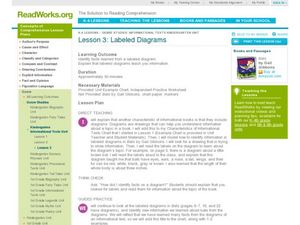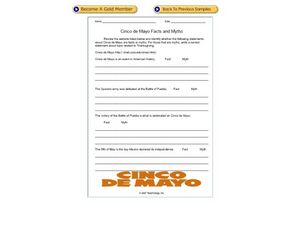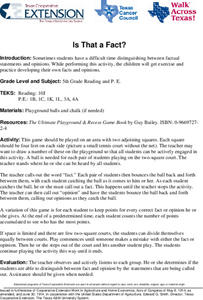Curated OER
Who's That Animal
Fourth graders travel through and explore various Internet web sites that have many different facts about animals. Then, they will pick one of the web sites and do more thorough research of an animal and write a feature article.
Curated OER
Nonfiction Text Features
Identify features of a nonfiction article in this language arts lesson. Middle schoolers apply comprehension strategies as they read the parts of the article, and analyze the author's key points. Additionally, they examine information in...
Curated OER
Addition
Explore the concept of number bonds with your young elementary students. They will become familiar with the number bonds to 10, 20, and 100, and then play games to practice these skills. This is a differentiated lesson which includes an...
Curated OER
All About Penguins
Second graders research penguins. In this all about penguins lesson, 2nd graders identify facts from their readings and write an expository paper using proper capitalization and punctuation.
Curated OER
Mystic Lands: Maya: Messages in Stone
Students explore an ancient Mayan city. In this world history lesson, students watch a video about the ancient Mayan civilization, discussing information prior to and after watching the video. Students then come to understand more about...
Curated OER
Author's Opinion
Students complete a worksheet. In this author's opinion lesson, students learn how to determine an author's opinion when it is not explicitly stated in the text. Students answer fact and opinion questions and use them to draw...
Curated OER
Text Features
Fifth graders utilize text features. In this text features lesson students read The Story of Jackie Robinson: Bravest Man in Baseball by Margaret Davidson. Students use clues from the table of contents, illustrations, and timeline to...
Curated OER
Fact
Students read about polar bears and discuss and identify the facts they learn about them. In this facts lesson plan, students explain why their facts are not opinions.
Curated OER
Labeled Diagrams
Let's learn about bats! Those flying creatures of the night inspire a lesson about non-fiction books. They start by charting characteristics commonly found in informational texts, specifically charts, diagrams, and labels. They look at...
Curated OER
Milton Hershey Quilt Activity
Students extend their understanding of Milton Hershey. In this notable figures lesson, students create a paper quilt about Milton Hershey. Students use the template provided to design their own quilt square, including an illustration and...
Curated OER
Cinco de Mayo Facts and Myths
In this Cinco de Mayo activity, students view a specific website on the computer and determine whether four statements are myths or facts. Students, if the statements are a myth, they write a sentence related to Thanksgiving on the lines...
Curated OER
Harriet Tubman Integrated Unit
Learners organize facts about Harriet Tubman. In this writing instructional activity, students research Harriet Tubman, sort facts about her into two categories, and use the information they have found to write about her life in complete...
Curated OER
Facts, Questions, Responses
In this graphic organizer worksheet, students use the double-T-Chart showing Facts, Questions, and Responses as a comprehension tool. Students list answers in three columns.
Curated OER
Is That a Fact?
Students write examples of facts and opinions on the board. In groups, they develop their own definitions for facts and opinions and share with the class. In new groups, they complete a worksheet in which they place statements into the...
Curated OER
Is That a Fact?
Fifth graders use physical activity to help them distinguish between facts and opinions. They are broken up into pairs and students give a fact or opinion (based on the call by the teacher) when the ball is bounced to them.
Curated OER
Louisiana
Third graders study factual information about Louisiana including the state flag, bird, tree, and important geographical points using the Internet and maps. They explain the different groups that settled the state in this mini-unit.
Curated OER
Readings in Hudson River Natural History: Understanding Informational Text
After reading a series of informational articles regarding the Hudson River Estuary, the class will answer a series of comprehension questions. An answer key is provided but the articles and worksheets are not.
Pennsylvania Department of Education
Analyzing Key Ideas and Details in Nonfiction
Students explore nonfiction texts. In this language arts lesson, students read a nonfiction text and make predictions. Students identify facts and opinions in the text and draw conclusions as they read.
Curated OER
Piecing Together the Story of Glenn Cunningham: A Kansas Champion
Students use primary and secondary sources to conduct research about Glenn Cunningham. In this Glenn Cunningham lesson plan, students tell why he was a hero, and tell facts from what they learned.
Curated OER
Google Earth Exercise: Rivers
For this Google Earth worksheet, students search the site and answer short answer questions about different rivers in the world. Students answer 11 questions.
Curated OER
Planet Research and Brochure
Fourth graders design a brochure based on the planet that they researched. In this planets lesson plan, 4th graders include the data, important facts, and completed as a team.
Curated OER
Butterfly Introduction
First graders create a KWL chart about butterflies and then read a story about butterflies. In this butterflies lesson plan, 1st graders then discuss the life cycle, body, habits, and facts about butterflies as they read.
Curated OER
Introduction to Dr. Seuss
First graders look at slides on the SMART Board of different facts about Dr. Seuss and then create a class bar graph of their favorite Dr. Seuss books. In this Dr. Seuss lesson plan, 1st graders review and list facts that they learned...
Curated OER
Distinguishing Facts from Opinions
Third graders use a scavenger hunt worksheet to look through classroom books and resources and identify facts and opinions. In this fact and opinion lesson plan, 3rd graders look through non fiction and fiction books.

























